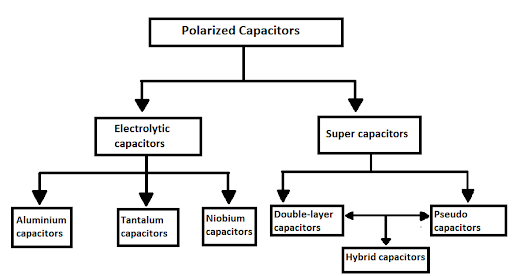
Which type of capacitor is known as a polarized capacitor?
Answer
219.3k+ views
Hint: First, familiarize yourself with the term capacitor associated with electronics. An electronic circuit almost always contains a capacitor because they are a necessary part of every electrical equipment. Whether or not a capacitor is polarized is one of the characteristics that identify it. This will help in answering the given question.
Complete step by step solution:
The capacitor is a device that can store electrical energy. It is a configuration of two conductors that typically carry charges of equal magnitudes and opposite signs and are spaced apart by an insulating medium. The non-conductive zone can be made of a dielectric, an electric insulator, or a vacuum, such as glass, paper, or air. Capacitors come in a variety of sizes and shapes, and they are used extensively in electronics.
The ones with particular positive and negative polarities are known as polarized capacitors. It is important to constantly ensure that the polarities of these capacitors are exact when utilizing them in circuits. The classification of polarized capacitors is displayed in the diagram below.

Only conductive liquid-based capacitors, also known as electrolyte-based capacitors, are polarized. Electrolytic capacitors made of tantalum, niobium, aluminum, and supercapacitors are all members of the polarized capacitor family. In polarized capacitors, electrochemical procedures are used. While supercapacitors employ a more intricate system of double-layer and reduction-oxidation (redox) reactions, electrolytic capacitors form a thin oxide layer on the anode plate. When the capacitor is correctly biased with the appropriate polarity, the outcome is a high or exceptionally high capacitance-to-volume ratio.
There is no preferred polarity for any of the other capacitor types, which include vacuum, film, mica, ceramic, air, etc., as they all rely solely on electrostatic processes.
Note: Positive and negative sides are present in polarized capacitors, although they are absent in ordinary capacitors. We must be careful to connect the positive side to the positive and the negative side to the negative when you connect them to a circuit. It could be connected incorrectly and end up damaging the capacitor. It could overheat in certain situations and become harmful.
Complete step by step solution:
The capacitor is a device that can store electrical energy. It is a configuration of two conductors that typically carry charges of equal magnitudes and opposite signs and are spaced apart by an insulating medium. The non-conductive zone can be made of a dielectric, an electric insulator, or a vacuum, such as glass, paper, or air. Capacitors come in a variety of sizes and shapes, and they are used extensively in electronics.
The ones with particular positive and negative polarities are known as polarized capacitors. It is important to constantly ensure that the polarities of these capacitors are exact when utilizing them in circuits. The classification of polarized capacitors is displayed in the diagram below.

Only conductive liquid-based capacitors, also known as electrolyte-based capacitors, are polarized. Electrolytic capacitors made of tantalum, niobium, aluminum, and supercapacitors are all members of the polarized capacitor family. In polarized capacitors, electrochemical procedures are used. While supercapacitors employ a more intricate system of double-layer and reduction-oxidation (redox) reactions, electrolytic capacitors form a thin oxide layer on the anode plate. When the capacitor is correctly biased with the appropriate polarity, the outcome is a high or exceptionally high capacitance-to-volume ratio.
There is no preferred polarity for any of the other capacitor types, which include vacuum, film, mica, ceramic, air, etc., as they all rely solely on electrostatic processes.
Note: Positive and negative sides are present in polarized capacitors, although they are absent in ordinary capacitors. We must be careful to connect the positive side to the positive and the negative side to the negative when you connect them to a circuit. It could be connected incorrectly and end up damaging the capacitor. It could overheat in certain situations and become harmful.
Recently Updated Pages
A square frame of side 10 cm and a long straight wire class 12 physics JEE_Main

The work done in slowly moving an electron of charge class 12 physics JEE_Main

Two identical charged spheres suspended from a common class 12 physics JEE_Main

According to Bohrs theory the timeaveraged magnetic class 12 physics JEE_Main

ill in the blanks Pure tungsten has A Low resistivity class 12 physics JEE_Main

The value of the resistor RS needed in the DC voltage class 12 physics JEE_Main

Trending doubts
JEE Main 2026: Application Form Open, Exam Dates, Syllabus, Eligibility & Question Papers

Understanding Uniform Acceleration in Physics

Derivation of Equation of Trajectory Explained for Students

Hybridisation in Chemistry – Concept, Types & Applications

Understanding the Angle of Deviation in a Prism

Understanding Collisions: Types and Examples for Students

Other Pages
JEE Advanced Marks vs Ranks 2025: Understanding Category-wise Qualifying Marks and Previous Year Cut-offs

Understanding Atomic Structure for Beginners

How to Convert a Galvanometer into an Ammeter or Voltmeter

Understanding Centrifugal Force in Physics

JEE Main Marking Scheme 2026- Paper-Wise Marks Distribution and Negative Marking Details

Degree of Dissociation: Meaning, Formula, Calculation & Uses




